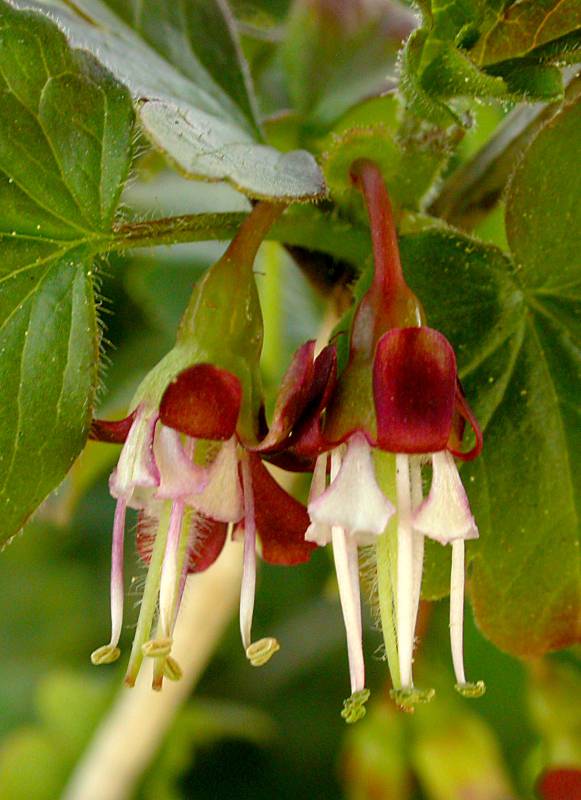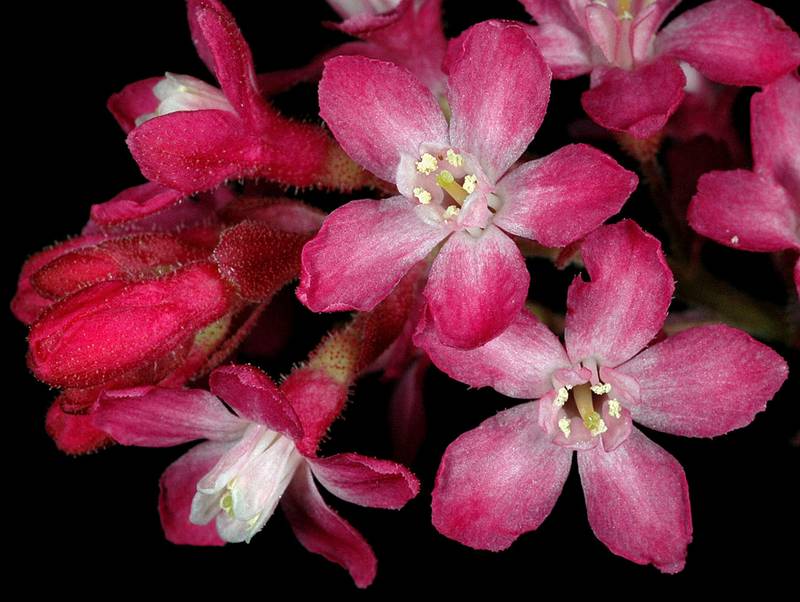Ribes divaricatum
Ribes sanguineum
coast black gooseberry, straggly gooseberry
blood currant, red currant, red flowering currant
Leaves alternate, palmately veined, broadly ovate, 2-6 cm. wide, rounded to cordate at the base, with rounded serrations, tri-lobed over half their length, the lower sections often shallowly cleft into 2 lobes.
Leaves alternate, petiolate, broadly reniform to deltoid-ovate, 2.5-6 cm. broad, the lower surface much paler and hairier than the upper, palmately 5-lobed, the lobes deltoid to rounded and finely denticulate.
Inflorescence of 2- to 3-flowered, drooping, slender racemes, shorter than the leaves;
pedicels slender, 5-10 mm. long;
calyx red to reddish-green, glabrous to pubescent, the calyx tube conic, 2.5 mm. long, the 5 lobes narrowly oblong, 5-7 mm. long, recurved;
petals 5, white to red, obovate, 1.5-2.5 mm. long;
stamens 5, longer than the calyx lobes;
styles 2, fused half their length, the fused half villous;
ovary inferior.
Inflorescence of erect, 10- to 20-flowered racemes;
pedicels jointed;
calyx pale to deep rose, finely pubescent;
calyx tube 3-5 mm. long and nearly a broad, the 5 lobes oblong, equal to the tube, spreading;
petals 5, white to light rose, obovate-spatulate, entire, 2.5-3.5 mm. long;
stamens 5, equaling the petals, the filaments pinkish;
styles 2, glabrous, fused almost to the stigmas;
ovary inferior.
Berry globose, smooth, purplish-black, about 1 cm. long.
Berry globose, 7-9 mm. long, glaucous-black.
Ribes divaricatum
Ribes sanguineum
- Local floras:
BC,
CA,
OR,
WA
- Local Web sites:
CalFlora,
CalPhotos,
Flora NW,
PNW Herbaria,
Turner Photog.
WildflowerSearch
iNaturalist (observations)
USDA Plants Database
- LBJ Wildflower Center
- SEINet
- Plants of the World Online
- Encyclopedia of Life
- Wikipedia
- Google Image Search
- Local floras:
BC,
CA,
OR,
WA
- Local Web sites:
CalFlora,
CalPhotos,
Flora NW,
PNW Herbaria,
Turner Photog.
WildflowerSearch
iNaturalist (observations)
USDA Plants Database
- LBJ Wildflower Center
- SEINet
- Plants of the World Online
- Encyclopedia of Life
- Wikipedia
- Google Image Search



